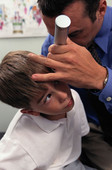
MONDAY, Nov. 1 (HealthDay News) — Black and Hispanic children with frequent ear infections are less likely to have access to health care than white children, say U.S. researchers.
They analyzed 1997 to 2006 data from the National Health Interview Survey and found that each year about 4.6 million children have frequent ear infections, defined as more than three infections over 12 months.
Overall, 3.7 percent of children with frequent ear infections could not afford care, 5.6 percent could not afford prescriptions, and only 25.8 percent saw a specialist, said the researchers at Harvard Medical School and the David Geffen School of Medicine at the University of California, Los Angeles.
When they focused on specific groups of children with frequent ear infections, the team found that:
- More black children (42.7 percent) and Hispanic children (34.5 percent) lived below the poverty level than white children (12 percent) and those of “other ethnicity” (28 percent).
- More Hispanic children (18.2 percent) and “other ethnicity” children (16.6 percent) were uninsured, compared to white children (6.5 percent).
- More white children (29.2 percent) had access to specialty care than black children (20 percent), Hispanic children (17.5 percent), and “other ethnicity” children (18.9 percent).
- More black children (28.4 percent) and Hispanic children (19.8 percent) than white children (15.5 percent) visited a hospital emergency department at least twice for ear infections over 12 months.
The study appears in the November issue of the journal Otolaryngology — Head and Neck Surgery.
“Our goal was to provide an accurate demographic picture of the U.S. so that we could identify disparities to target for intervention,” study co-author Dr. Nina Shapiro, director of pediatric otolaryngology at Mattel Children’s Hospital UCLA and an associate professor of surgery at the Geffen School of Medicine, said in an American Academy of Otolaryngology — Head and Neck Surgery news release.
“Clearly, we found that children of certain ethnicities who suffer from frequent ear infections are more likely to face greater barriers to care. This information provides an opportunity for improvements in our current healthcare reform,” she added.
More information
The U.S. National Institute on Deafness and Other Communication Disorders has more about ear infections in children.

